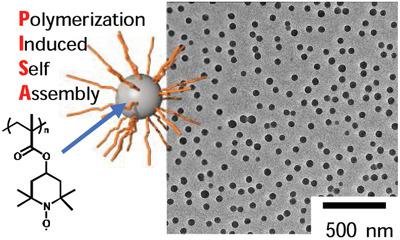当前位置:
X-MOL 学术
›
Macromol. Chem. Phys.
›
论文详情
Our official English website, www.x-mol.net, welcomes your feedback! (Note: you will need to create a separate account there.)
Redox Polymer–Based Nano‐Objects via Polymerization‐Induced Self‐Assembly
Macromolecular Chemistry and Physics ( IF 2.5 ) Pub Date : 2019-08-21 , DOI: 10.1002/macp.201900296 Fadoi Boujioui 1 , Flanco Zhuge 1 , Jean‐François Gohy 1
Macromolecular Chemistry and Physics ( IF 2.5 ) Pub Date : 2019-08-21 , DOI: 10.1002/macp.201900296 Fadoi Boujioui 1 , Flanco Zhuge 1 , Jean‐François Gohy 1
Affiliation

|
Poly(2,2,6,6‐tetramethylpiperidinyloxy‐4‐yl‐methacrylate) (PTMA) redox polymer–based nano‐objects are synthesized by polymerization‐induced self‐assembly with poly[oligo(ethylene glycol) methyl ether methacrylate] and poly[(4‐methacryloyloxy)‐2,2,6,6‐tetramethylpiperidinium chloride] as hydrophilic macro‐chain transfer agents. These hydrophilic blocks are used in order to stabilize hydrophobic PTMA blocks in aqueous medium. The accordingly obtained spherical nano‐objects are observed via transmission electron microscopy analysis. Cyclic voltammetry measurements indicate that the nature and the length of coronal blocks influence the redox process of the PTMA core blocks. Moreover, these electroactive nano‐objects display low viscosities with a shear‐thinning behavior, making them suitable as cathode‐active materials for aqueous flow‐assisted electrochemical systems.
中文翻译:

通过聚合诱导的自组装基于氧化还原聚合物的纳米物体
聚(2,2,6,6-四甲基哌啶基氧基-4-基甲基丙烯酸酯)(PTMA)氧化还原聚合物基纳米物体是通过聚合诱导的自组装与聚[低聚(乙二醇)甲基丙烯酸甲酯)合成的。聚[(4-甲基丙烯酰氧基)-2,2,6,6-四甲基氯化哌啶]作为亲水性大链转移剂。使用这些亲水性嵌段是为了使疏水性PTMA嵌段在水性介质中稳定。通过透射电子显微镜分析观察到相应获得的球形纳米物体。循环伏安法测量表明,冠状嵌段的性质和长度会影响PTMA核心嵌段的氧化还原过程。此外,这些电活性纳米物体显示出低粘度和剪切稀化行为,
更新日期:2019-08-21
中文翻译:

通过聚合诱导的自组装基于氧化还原聚合物的纳米物体
聚(2,2,6,6-四甲基哌啶基氧基-4-基甲基丙烯酸酯)(PTMA)氧化还原聚合物基纳米物体是通过聚合诱导的自组装与聚[低聚(乙二醇)甲基丙烯酸甲酯)合成的。聚[(4-甲基丙烯酰氧基)-2,2,6,6-四甲基氯化哌啶]作为亲水性大链转移剂。使用这些亲水性嵌段是为了使疏水性PTMA嵌段在水性介质中稳定。通过透射电子显微镜分析观察到相应获得的球形纳米物体。循环伏安法测量表明,冠状嵌段的性质和长度会影响PTMA核心嵌段的氧化还原过程。此外,这些电活性纳米物体显示出低粘度和剪切稀化行为,



























 京公网安备 11010802027423号
京公网安备 11010802027423号